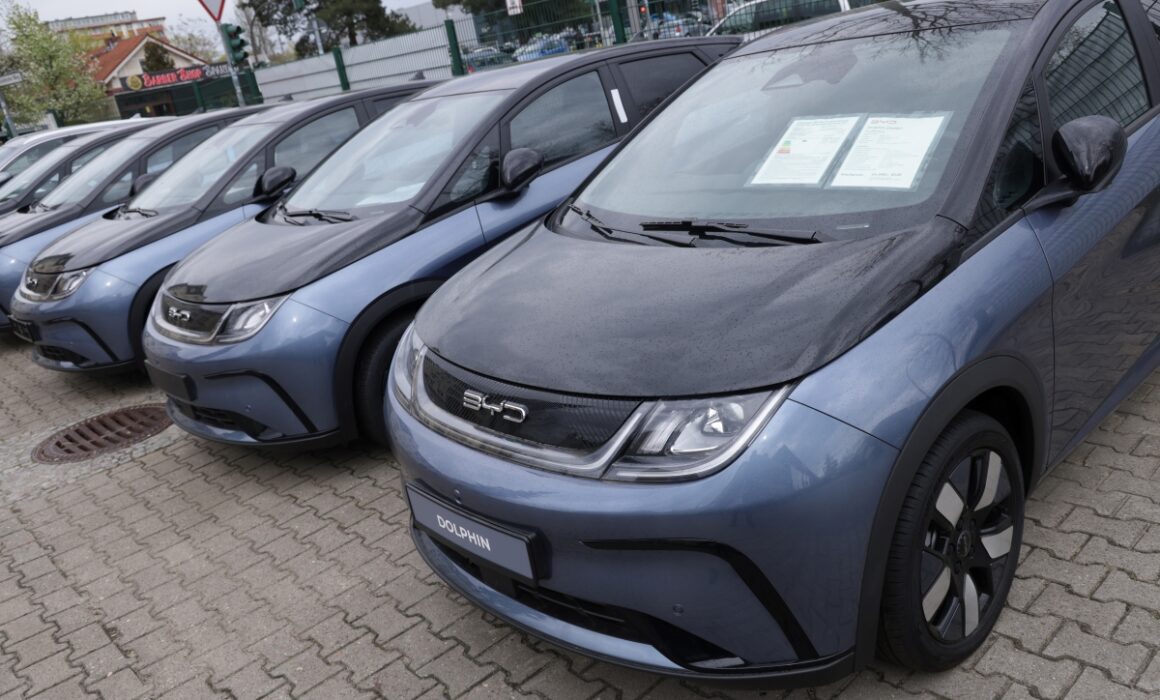Why It’s Good, Actually, That You Can’t Buy the World’s Cheapest Electric Vehicle
May 13, 2024
By Elizabeth Pancotti
Fireside Stacks is a weekly newsletter from Roosevelt Forward about progressive politics, policy, and economics. We write on the latest with an eye toward the long game. We’re focused on building a new economy that centers economic security, shared prosperity, and rebalanced power.
(Photo by Sean Gallup/Getty Images)
Chinese auto manufacturer BYD is on a mission to open “a new era where electricity is cheaper than oil” with the launch of their $10,000 EV, the Seagull. The Seagull, which starts at just one-third of the starting price of a Nissan Leaf and one-fourth of the starting price of a Tesla Model 3, has a range of up to 250 miles (compared to the Leaf’s 149) and plugs into a regular household outlet.
People are excited about the Seagull and BYD’s other cheap EVs. Dylan Matthews at Vox wrote last month about BYD’s “absolutely screaming deals” for their cheap EVs, claiming they are “the kind of products that could turbocharge our transition away from gas and toward electric vehicles.” Robinson Meyer wrote a New York Times op-ed titled “China’s Electric Vehicles Are Going to Hit Detroit Like a Wrecking Ball,” arguing that “BYD’s cars deliver great value at prices that beat anything coming out of the West.” Andy Hawkins from The Verge said BYD is putting pressure on other EV makers to lower prices and giving Tesla a run for its money.
She’s cute! She’s tiny! She vaguely resembles the Pea Car! And you can’t have her.
BYD cars aren’t available in the US. According to their executives, the market is “very complicated.” This is for a lot of reasons, but namely, vehicles imported from China face a 25 percent tariff. The Biden administration is set to quadruple this to 100 percent tomorrow. Further, in order to be eligible for the EV tax credits included in the Inflation Reduction Act, cars not only have to be assembled in North America, but their critical minerals and other battery components have to be mined, processed, manufactured, and/or assembled in the US (or one of its trading partners). The Seagull and other BYD models, on top of the tariff, are not eligible for the $7,500 consumer tax credit, driving sticker prices up significantly.
Some policymakers are calling for Chinese EVs to be banned in the US altogether—or for tariffs to be raised even higher than what Biden is set to announce tomorrow. Others argue that the “bizarre” restrictions leave Americans out of the bounty of cheap EV options and “make no sense from a climate perspective.”
What gives? As MIT economist David Autor put it, “There are few things that would decarbonize the US faster than $20,000 EVs. But there is probably nothing that would kill the US auto industry faster, either,”—an industry that drives 5 percent of GDP and 10 million American jobs.
EVs accounted for only 18 percent of all cars sold last year, even in the wake of expanded federal subsidies for consumers. Today, just 1 percent of cars on the road in the US are electric, and that slow uptake has driven lots of discourse. They’re expensive (“we just don’t have an EV equivalent of a Toyota Corolla”), they’re no match for Chicago winters, they’re “woke.”
We have to accelerate the transition away from gas-powered vehicles to reach our climate goals. Greenhouse gas emissions from transportation account for about 30 percent of US emissions, and passenger vehicles make up about half of that. But the answer to the $10,000 question of how we very quickly electrify the transportation sector can’t be a car that’s too cheap.
How do you make an electric car for one-third of the price of the next guy? You cut corners, hurting workers, the environment, and ultimately consumers.
China has fueled a race to the bottom when it comes to labor and environmental standards for EV inputs.
Last year, Canadian Prime Minister Justin Trudeau remarked that “lithium produced in Canada is going to be more expensive” because the country doesn’t use slave labor; requires living wages; and enforces environmental, security, and safety standards. For nearly 15 years, the US Department of Labor has recognized the prevalence of child labor in the Democratic Republic of the Congo’s cobalt mining operations—80 percent of which are owned by Chinese firms. Extensive reporting has traced battery and other EV component supply chains to the Xinjiang region of China, where Uyghur forced labor is rampant.
Because of historic wins by the UAW, Ford pays the workers who make the F-150 Lightning living wages and provides them with decent benefits. Comparatively, BYD workers earn a base salary of $324 per month, or just 20 percent of national average wages.
Chinese aluminum firms have ravaged farmlands and water reservoirs in Guinea to rapidly expand bauxite mines. Primarily Chinese-backed nickel mining and refining in Indonesia, lacking sufficient environmental regulation, have contaminated seawater and estuaries and contributed to high rates of respiratory infections. For graphite, though the industry has made significant progress on synthetic production, the process is extremely energy-intensive, and in China, primarily fueled by coal.
About 40 percent of an EV’s price is driven by the cost of the battery. EV batteries have come down by nearly 90 percent over the past 15 years as technologies have improved and manufacturing capacity has scaled up. But the battery market isn’t a gold-star example of perfect competition from an economics textbook.
The supply chains for battery input materials are extremely concentrated. Australia and China control 72 percent of lithium mining. Indonesia, the Philippines, and Russia control 65 percent of nickel production. The Democratic Republic of the Congo controls 74 percent of cobalt mining. A look at global flows for refined material tells an even worse story for energy security and resiliency: China controls between 59 and 72 percent of refining and processing for critical minerals required for EV batteries. (If you love a good chart, this excellent new paper from researchers at the Carnegie Mellon Scott Institute for Energy Innovation has great Sankey diagrams for these supply chains). China produces some 70 percent of the world’s graphite. Once the raw materials are refined and processed, China makes 77 percent of the world’s cathodes (the positive parts of the battery) and 92 percent of anodes (the negative parts).
As a result, 66 percent of the world’s battery cells are produced in China. According to the International Energy Agency, China dominates almost “every stage of the EV battery supply chain.” This concentration and overreliance on a single source threatens energy security, creates and contributes to national security risk, and paves the way for price manipulation.
To compare, OPEC’s 13 member countries produce 40 percent of the world’s crude oil and provide about 60 percent of global petroleum trades. The US, China, and Russia, combined, control 42 percent of oil refining capacity. Even with significantly lower levels of concentration, large oil-producing countries yield enough power to manipulate prices and supply.
If Saudi Arabia and Russia can cause a 25 percent price spike in oil in just three months by cutting production, imagine what one country with three times the market power could do to batteries. China recently restricted exports of two critical minerals necessary for semiconductors, for which it controls between 60 and 80 percent of global supply, in retaliation over US export limitations on chips. Prices have soared, nearing 13-year highs.
As we once again stare down higher prices at the gas pump as a result of geopolitical conflict, it really begs the question: Have we learned nothing from the consequences of concentrated oil markets and laissez-faire attitudes when it comes to energy security?
As automakers expand domestic EV manufacturing, mining and processing firms increase the domestic supply of EV inputs, and the UAW organizes US plants, they are raising the floor for standards in the EV industry and creating a diversified, competitive, and resilient market. This might mean we never have a $10,000 EV. But maybe that shouldn’t be the goal. Instead, we should build a green economy that ensures autoworkers can afford the car they make.
Matthews claims keeping BYD out of the US amounts to sabotaging our climate goals in the name of sticking it to the Chinese. The Atlantic’s Rogé Karma says we have to pick between super cheap electric cars or an American industrial renaissance. I’d say, instead, we have to think strategically about simultaneously meeting our climate targets and rebuilding the middle class. That might involve some trade-offs, where we opt for a smarter long game over a precarious short-term remedy. As BloombergNEF’s Corey Cantor said on Odd Lots last year, automakers are trying to figure out how they “make EVs cost less while keeping workers happy while still making a profit.”
There’s reason to believe we can get there quickly and sustainably, creating good union jobs and investing in communities that have been hollowed out by decades of cost primacy. The Department of Energy’s Loan Programs Office (LPO) announced a $2.3 billion loan last month for Lithium Americas for a lithium processing facility in Thacker Pass, NV. GM is investing $650 million in the facility and has a 100 percent offtake agreement for up to 15 years, onshoring its lithium supply for EV batteries. In June, LPO announced a $9 billion loan for BlueOval SK to build three manufacturing plants that will produce batteries for Ford and Lincoln EVs. Stellantis announced it’s finally turning a profit on EVs in February, and it’s investing over $3 billion to expand EV battery manufacturing in Kokomo, IN.
While the price of the Seagull may be low, the cost of it is high. It jeopardizes energy security and workers’ livelihoods. A fair and sustainable clean energy transition must center a reorientation away from cost and efficiency primacy and toward resiliency and responsibility. Flooding the market with cheap electric vehicles may, in the short term, accelerate the transition away from gas-powered vehicles, but as Meyer put it in the Times, it could wash away the bridge domestic automakers—and other manufacturers along the EV supply chain—are building before they have finished building it.
To be clear, we need an EV equivalent of the Toyota Corolla and the Ford Explorer, and we need you and your mom to buy them. But if we repeat the mistakes and failures that led to economic catastrophe in Detroit and Pittsburgh over the past 50 years, the price we pay will be far greater than the savings we reap from the cute, cheap, green cars.
If You Ask Eleanor
As we have developed, we think it is within our rights to know under what conditions any work is performed, and whether the wages paid make it possible for a family to maintain a decent standard of living.
– Eleanor Roosevelt, If you ask me (1946)



